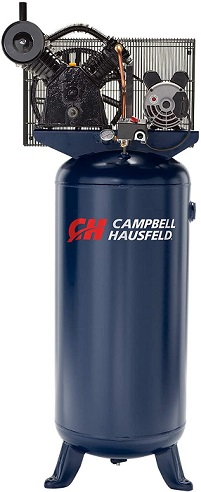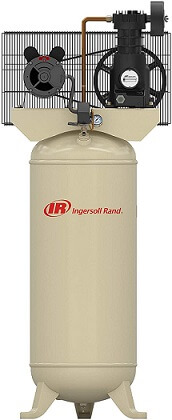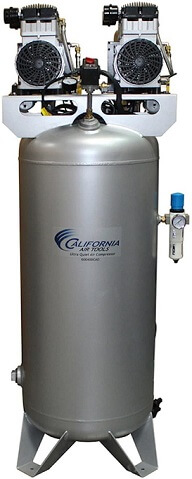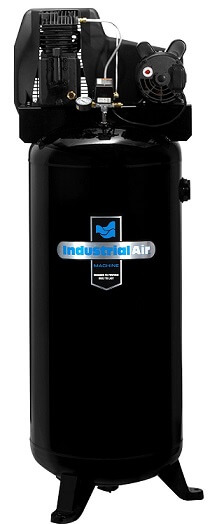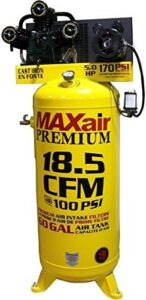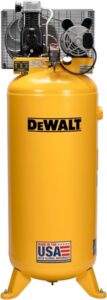Looking for the best 60-gallon air compressor to power your tools and projects? Choosing the right model can significantly impact your work efficiency and outcome. When investing in an air compressor, you’ll want to consider key features that align with your needs—whether for home projects or more demanding industrial tasks.
Here’s what you should seek in terms of specs and performance:
- Maximum Air Pressure:For home use, aim for 125 to 135 PSI. For heavy-duty tasks, go for around 175 PSI.
- Motor Power:Look for compressors with motors from 5 to 7.5 HP for better performance.
- Air Flow Capacity:Aim for 4 to 5 CFM for consistent airflow.
In this article, we have curated a list of top-performing 60 Gallon Air Compressors with a comprehensive “Buying Guide.”
Best 60 Gallon Air Compressors – Table
| 60 Gallon Air Compressors | Maximum Pressure | Motor Power | Air Flow Capacity | Buy Now |
|---|---|---|---|---|
| Campbell Hausfeld Compressor | 175 PSI | 3.7 HP | 7.6 CFM | Check On Amazon |
| Ingersoll Rand Compressor | 135 PSI | 5 HP | 18.1 CFM | Check On Amazon |
| California Air Tools Compressor | 90 PSI | 2 HP | 10.60 CFM | Check On Amazon |
| Industrial Air Compressor | 155 PSI | 3.7 HP | 15.3 CFM | Check On Amazon |
| PowerMate Air Compressor | 155 PSI | 3.7 HP | 10 OR 11 CFM | Check On Amazon |
| Maxair Air Compressor | 175 PSI | 5 HP | 18.5 CFM | Check On Amazon |
| DEWALT Air Compressor | 175 PSI | 3.7 HP | 11.5 CFM | Check On Amazon |
Best 60 Gallon Air Compressors – Reviews
1. Campbell Hausfeld Compressor
The Campbell Hausfeld XC602100 is notable for its powerful oil-lubricated, two-stage pump, perfect for tough tasks. It features a 230-volt, 3.7 horsepower motor, ensuring strong performance for pros and DIYers alike.
Its 60-gallon vertical tank saves space in the workshop and offers plenty of air for longer tool use. While sturdy, some users have reported occasional leaks and noise, suggesting room for better quality control.
Specifications
- Voltage: 230 Volts
- Horsepower: 3.7 HP
- Maximum Pressure: 175 PSI
- Air Flow Capacity: 7.6 SCFM @ 90 PSI, 6.9 SCFM @ 175 PSI
- Product Dimensions: 33″L x 29″W x 77″H
- Item Weight: 255 Pounds
- Recommended Uses: Sanding, Grinding
- Noise Level: 65 dB
Pros
- Long-lasting pump with 5,000 hours of operation.
- Powerful motor for versatile tool operation.
- Space-saving vertical tank design.
- Fully enclosed metal belt guard for safety.
Cons
- No power cord is included.
2. Ingersoll Rand Compressor
The sturdy construction with robust performance of the Ingersoll Rand SS5 60-gallon compressor makes it perfect for tough jobs. It’s built for continuous duty, with a single-stage pump that works reliably up to 135 PSI.
Though powerful, its noise level at 78 dB might not suit all settings. However, its durability, offering over 5,000 hours of trouble-free use, makes it a wise investment for pros and dedicated DIYers needing reliable high-pressure air delivery.
Specifications
- Power: 5HP
- Phase: Single-phase
- Duty Cycle: 100% continuous duty
- Maximum Pressure: 135 psi
- Airflow Rate: 18.1 CFM at 90 psi
- Noise Level: 78 dB
- Tank Type: Vertical ASME receiver tank
- Safety: Manual thermal overload protection
Pros
- Durable cast iron construction for longevity.
- Automatic start/stop for user convenience.
- Fully assembled and pre-wired delivery
- All Season Select synthetic lubricant for increased efficiency
Cons
- May require additional maintenance over time.
3. California Air Tools Compressor
The quiet operation of the California Air Tools at just 75 dB is impressive. Its high-efficiency, oil-free pump reduces maintenance demands. With a dual motor design providing a combined power of 4.0 HP, it delivers strong performance while minimizing wear and ensuring longer durability.
The compressor’s 60-gallon capacity and 10.60 CFM at 90 PSI enable sustained tool operation, catering to both professional and personal needs. It’s an ideal choice for environments prioritizing noise reduction and low
maintenance, offering a seamless blend of functionality and ease of use.
Specifications
- Noise Level: 75 dB
- Motor Power: Two powerful 2.0 HP motors
- Tank: Steel ASME air tank
- Airflow: 10.60 CFM at 90 PSI, 12.60 CFM at 40 PSI
- Power Source: Electric
- Special Feature: Oil-Free
Pros
- Lasts long, has reliable performance
- Suitable for various tasks and environments
- Needs less fixing, saves money
- Simple to operate, no complicated buttons
Cons
- Noise level may still be noticeable to some users.
4. Industrial Air Compressor
Another great option is the ILA3606056 air compressor from Industrial Air. This compressor is designed to withstand tough environments, thanks to its durable construction. It features a twin-cylinder cast iron pump, ensuring both reliability and performance.
With a maximum pressure of 155 PSI, it’s suitable for demanding tasks. While it delivers a strong air flow of 11.5 CFM at 90 PSI, it’s worth noting that it’s not the most energy-efficient option and operates at a noise level of 68 dB.
However, for heavy-duty applications, such as workshops or job sites, it remains a solid choice for professionals seeking a reliable workhorse.
Specifications
- Maximum Pressure: 175 PSI
- SCFM @ 100 PSI: 15.3
- SCFM @ 175 PSI: 13.5
- Pump RPM: 767
- Voltage: 230 Volt
- Phase: Single
- Running HP: 5.0
Pros
- Heavy-duty construction for durability.
- Thermal overload protection for motor safety.
- Patented pump design for cooler operation.
- Ample air supply for multiple tools.
Cons
- Some users reported issues with oil leaks.
5. PowerMate Air Compressor
Up next is the Maxair C5160V1-MAP, known for its exceptional performance and reliability. With a sturdy 5HP motor and a maximum pressure of 170 PSI, it’s built to handle tough tasks. Its airflow rate of 18.5 CFM at 100 PSI ensures it can power various tools efficiently.
Despite its power, it operates quietly compared to similar compressors. Its durable construction ensures long-term use, making it suitable for both professionals and avid DIYers. With its array of features, this compressor stands out for those needing a reliable option for demanding tasks.
Specifications
- Voltage: 230 Volts (AC)
- Recommended Uses For Product: Drilling, Air Brushing, Spraying, Nailing
- Power Source: Electric-powered
- Special Feature: Heavy Duty
- Capacity: 60 Gallons
- Air Flow Capacity: 18.5 Cubic Feet Per Minute
- Motor Horsepower: 3.7 HP
- Maximum Pressure: 155 PSI
Pros
- Durable cast iron construction.
- Suitable for various applications.
- Provides consistent air supply.
Cons
- Requires a dedicated electrical circuit.
6. Maxair Air Compressor
PowerMate is a reliable brand when it comes to portable and home standby generators, et al. And when it comes to air compressors, the Vx PLA3706056 60-gallon air compressor is worth buying.
It has a cast iron twin-cylinder pump and a heavy-duty motor. This provides steady performance. With 155 PSI maximum pressure, it is good for many high-demand tasks, like spraying and nailing.
While it works well, the noise level is somewhat high. This might be a problem if you need a quiet environment. Its durability and performance make it great for professional use. And when it comes to its installation, it’s easy. This is a plus for those who value efficiency and performance in their tools.
Specifications
- Power Source: Electric-powered
- Recommended Uses: Drilling, Air Brushing, Spraying, Nailing
- Special Feature: Heavy Duty
- Motor Horsepower: 5 HP
- Capacity: 60 Gallons
- Air Flow Capacity: 18.5 Cubic Feet Per Minute
Pros
- Quick and easy setup, saving time on installation
- Heavy-duty construction ensures durability.
- Extended drain for convenient maintenance.
- Suitable for a wide range of tasks, from small DIY projects to professional use
Cons
- Limited portability due to its stationary design.
7. DEWALT Air Compressor
And the last product on the list of the top air compressors is from Dewalt. Compared to the other models, the DXCM602 offers an impressive 175 maximum PSI. This provides more than twice the air tool run time.
With 11.5 SCFM at 90 PSI, it ensures quick recovery and efficient operation of multiple tools at the same time. However, its noise level of 87 dB can be quite loud. This unit is perfect for those who need consistent, high-pressure performance in professional settings.
Its sturdy build and reliable operation make it a good investment for serious users. Despite this, its noise might mean you need a dedicated workspace away from quiet areas.
Specifications
- Maximum PSI: 175
- Capacity: 60 Gallons
- Power Source: Corded Electric
- Motor Horsepower: 3.7 HP
- Air Flow Capacity: 11.5 Cubic Feet Per Minute
- Voltage: 208 Volts
- Noise Level: 87 dB
- Special Feature: Heavy Duty
- Item Weight: 200 Pounds
Pros
- Superior performance for extended tool run time.
- Efficient air delivery for various applications.
- Robust and durable construction.
- Easy to transport and secure.
Cons
- Requires a specific power supply configuration.
How To Choose The Best 60 Gallon Air Compressor?
When selecting a 60-gallon air compressor, several key factors should be considered to ensure you’re investing in the right equipment for your needs. Here’s a comprehensive guide to help you make an informed decision:
1. Maximum Air Pressure (PSI)
When picking a 60-gallon air compressor, the max air pressure (PSI) matters a lot. It tells you how versatile and efficient the compressor is. For everyday tasks at home, aim for 125-135 PSI. But if you’re doing heavy-duty work, look for one with up to 175 PSI. Adjustable pressure settings give you more flexibility.
2. Motor Power (HP)
The horsepower (HP) of the motor in a 60-gallon air compressor affects how well it works. A motor with 5 to 7.5 HP will handle regular and tough jobs. Choose a compressor with high horsepower and a reliable, efficient motor.
3. Air Flow Capacity (CFM)
CFM (cubic feet per minute) shows how much air the compressor gives out each minute. It’s crucial for keeping a steady air supply during use. For a 60-gallon compressor, 4 to 5 CFM is usually enough for general use. But remember, things like temperature and altitude can affect performance.
4. Type of Air Compressor
Picking the right type of air compressor is key. Single-stage ones are simple and affordable, good for light to medium use. Two-stage compressors are more efficient and work well for continuous, tough jobs, especially in bigger 60-gallon models.
5. Duty Cycle
The duty cycle shows how long the compressor can run before needing a break to cool down. Think about your needs—whether you want a 50% duty cycle for 30 minutes of use every hour, or a 100% duty cycle for non-stop operation.
6. Power Source
Decide between electric and gas-powered compressors based on where you’ll use them. Electric ones are quieter and better for indoors, while gas-powered ones are more portable for outdoor jobs.
7. Oil and Oil-Free Compressors
Choosing between oil-lubricated and oil-free compressors depends on air purity needs and how much maintenance you can do. Oil-lubricated ones run smoother and last longer but need regular upkeep. Oil-free ones are good for clean-air tasks like painting.
8. Noise Level
Noise matters, especially in quiet places. Get a 60-gallon compressor with low decibel ratings to minimize noise. Look for features like vibration dampeners and noise insulation for quieter use.
9. Safety Standards
Make sure your 60-gallon air compressor meets safety standards from UL or CSA. Look for safety features like pressure relief valves and thermal overload protection to prevent accidents or malfunctions.
What are the advantages of 60-gallon air compressor?
- They don’t produce any noise. So, you can use it wherever you want without or family members.
- These machines are quite easy to set up.
- They deliver almost instant performance as soon as you turn them on.
- It has maximum efficiency of 240 volts which makes it possible to handle all the tasks easily.
- They can also be used for tasks like spray guns, ratchets, impacts and hammers.
- These machines have adequate power to handle more than a single air tool or device.
- It comes with specially designed and patented pump.
60 Gallon Air Compressor – FAQs
The first thing to do is – connect the air hose. Because the voltage drop will lead to issues with air compressors (high current devices). Once the air compressor is turned on, the tank will be automatically filled up to its maximum capacity. After that, it will be turned off until you use the supply. It will get refilled later as required.
Once you have figured out where you want to place the air compressor and whether the hose length is adequate enough to reach your work area – you should set up the compressor on isolator pads. This will provide stability and minimize the noise caused by vibrations. If required, fix an air filter to the compressor side to make sure the dispensed air is clean. If you the air compressor is electrically powered, then select a proper power outlet before activating any tools.
Instead of power extensions, it is better to use hose extensions for reaching necessary voltage dropout. Now, you can plug any tools as required. Make sure to check the oil levels before using it. Once the machine is turned on, air will be filled automatically to its maximum level. And then it will switch off until the air is used. It can be refilled again when required.
12/3 wire should never be used as they will melt down. 6/2 or 8/2 is the minimum required. The wire should have the same gauge as the compressor. Check out the instruction manual. The motor actually calls for 50amp breaker according to instructions.
One of the factors to consider while purchasing an air compressor is to know where you are going to use them. Some of them are suitable for using outdoors while some of them are specifically designed for indoor use. These two cannot be interchanged the compressor is built for that particular environment.
When it comes to 60-gallon air compressors, it is not suitable for outdoor operations. They are just stationary tanks which have the capability to power up one or multiple pneumatic tools based on the application and type. They are designed for indoors but can be used outdoors in some conditions. However, they should never be exposed to rain, snow, high winds, heat or any other weather extremes. If so, then they can damage the interiors and decrease their lifespan of the compressor drastically.
here are two different pump types – reciprocating and rotary. Reciprocating are suitable for portable and smaller applications. Rotary pumps are suitable for large applications.
Reciprocating Pumps – They compress air using pistons which move up and down within the cylinders. They are usually seen in manual bicycle pumps.
Rotary pumps – air compressors with this type of pumps have two rotors which turn in opposite directions. Air trapped between will cause compression. As they operate in rotary motion, the compressed air will be transferred from one to another. In general terms, they are referred as centrifugal pumps. They are usually used in clothes dryer.
CFM (cubic feet per minute) lets you know how fast the air compressor will work. For powerful tools, you need an air compressor with large tank. However, higher CFM will ensure the pressure stays longer. As gases can change the pressure based on humidity, temperature and other factors, CFM can be a variable option. Some brands list CFM in a way that doesn’t correspond to real-world conditions. This actually makes the whole air compressor look heavier that it is.
SCFM reads for standard cubic feet per minute. It is actually calculated CFM based on extraneous factors held constant. This lets you compare the models properly.
Conclusion
Choosing the best 60-gallon air compressor depends on your needs and budget. Here are three top contenders:
- For value and power: The Campbell Hausfeld Compressor offers a reliable two-stage pump, a high 175 PSI, and a budget-friendly price.
- For quiet operation: The California Air Tools Compressor boasts exceptional noise reduction and an oil-free design for easy maintenance, making it ideal for indoor use.
- For professional applications: The Ingersoll Rand Compressor packs a powerful 5HP motor and a single-stage pump, delivering consistent airflow for demanding tasks.
Consider these factors when making your final decision: noise level, oil-free operation, pressure and CFM (cubic feet per minute) delivery, and your budget.

